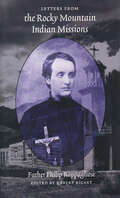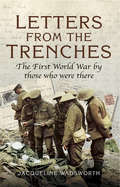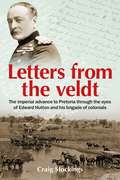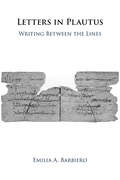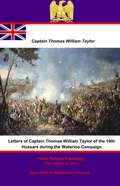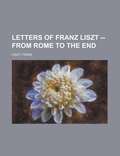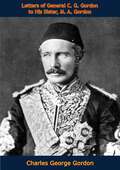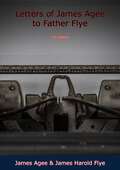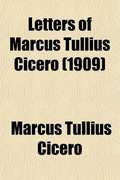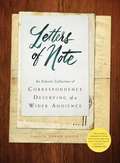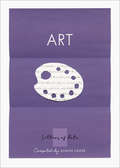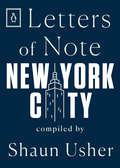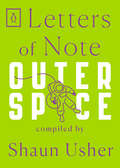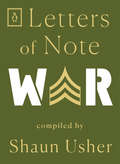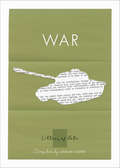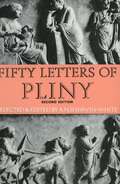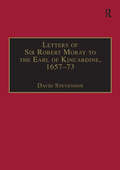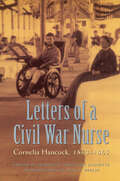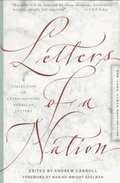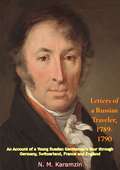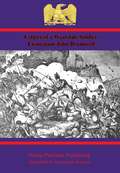- Table View
- List View
Letters from the Rocky Mountain Indian Missions
by Philip RappagliosiLetters from the Rocky Mountain Indian Missions reveals the life of an Italian Jesuit as he worked at three missions in the northern Rocky Mountains from 1874 to 1878. Meticulously translated and carefully annotated, the letters of Father Philip Rappagliosi (1841–78) are a rare and rich source of information about the daily lives, customs, and beliefs of the many Native peoples that he came into contact with: Nez Perces, Kootenais, Salish Flatheads, Coeur d&’Alenes, Pend d&’Oreilles, Blackfeet, and Canadian Métis. These never-before-translated letters reveal the shifting, sometimes volatile relationship between the missionaries and the Native Americans and also provide a window into the complex lives of the Jesuits. After requesting to work among the Native peoples of the American West, Rappagliosi arrived at Saint Mary&’s Mission in the Bitterroot Valley of Montana in 1874, where he spent much time among already converted members of the Salish Flathead Nation. The energetic Rappagliosi journeyed next to Canada to visit some Kootenai Indian bands and then was reassigned to Saint Ignatius Mission, where he interacted with the Upper Pend d&’Oreilles Indians. Rappagliosi&’s final and most difficult assignment was at Saint Peter&’s Mission among the Blackfeet in Montana, who were not converts. There he became embroiled in disputes with a controversial former Oblate priest, and foul play was suspected in his death at the age of thirty-seven.
Letters from the Southern Home Front: The American South Responds to the Vietnam War
by Joseph A. FryJoseph A. Fry’s Letters from the Southern Home Front explores the diversity of public opinion on the Vietnam War within the American South. Fry examines correspondence sent by hundreds of individuals, of differing ages, genders, racial backgrounds, political views, and economic status, reflecting a broad swath of the southern population. These letters, addressed to high-profile political figures and influential newspapers, took up a myriad of war-related issues. Their messages enhance our understanding of the South and the United States as a whole as we continue to grapple with the significance of this devastating and divisive conflict.
Letters from the Trenches: The First World War by Those Who Were There
by Jacqueline WadsworthA history of World War I—told through the letters exchanged by ordinary soldiers and their families. Letters from the Trenches reveals how people really thought and felt during the Great War, and covers all social classes and groups from officers to conscripts to women at home to conscientious objectors. Voices within the book include Sgt. John Adams, 9th Royal Irish Fusiliers, who wrote in May 1917: &“For the day we get our letter from home is a red letter day in the history of the soldier out here. It is the only way we can hear what is going on. The slender thread between us and the homeland.&” Pvt. Stanley Goodhead, who served with one of the Manchester Pals battalion, wrote home in 1916: &“I came out of the trenches last night after being in four days. You have no idea what four days in the trenches means . . . The whole time I was in I had only about two hours sleep and that was in snatches on the firing step. What dugouts there are, are flooded with mud and water up to the knees and the rats hold swimming galas in them . . . We are literally caked with brown mud and it is in all our food, tea etc.&” Jacqueline Wadsworth skillfully uses these letters to tell the human story of the First World War: what mattered to Britain&’s servicemen and their feelings about the war; how the conflict changed people; and how life continued on the home front.
Letters from the Veldt: The imperial advance to Pretoria through the eyes of Edward Hutton and his brigade of colonials.
by Craig StockingsThe South African War – or Boer War – running from 11 October 1899 until 31 May 1902 –was the largest British military effort since the Napoleonic Wars. It was also the first time that large-scale, meaningful contributions were made to an active theatre of war by the self-governing colonies. This included formal contributions of around 20,000 troops from the Australian colonies which dwarfed all previous Australian military commitments. Just as the war was a watershed event for the development and professionalisation of the British Army from 1902-14, it was momentous for the self-governing colonies in Australia and elsewhere in social, political and most certainly in military terms.Letters from the Veldt sheds light on the activities of imperial military contingents – in which Australians served – during the Imperial march to Pretoria from May-September 1900, the successful conclusion of which marked the end of &‘conventional&’ operations in South Africa and the beginning of the &‘guerrilla&’ phase that would drag on until May 1902. A large proportion of colonial troops serving in South Africa at this point did so as part of the 1st Mounted Infantry Brigade. Despite their importance, the experiences of this brigade have not figured largely in existing any accounts of the Boer War. The brigade itself was composed of not only Australians, but Canadians, New Zealanders, and British regular and volunteer troops, and a scattering of &‘loyal&’ South Africans. It was in many ways a microcosm of imperial military cooperation; an important part of the steady development of attitudes, expectations and shared experience which led to the formation in 1914 of a much larger expeditionary force. This account does not follow a standard pattern or format – there is no measured, steady traditional narrative. Rather, the experiences of the 1st Mounted Infantry Brigade, and the light they shed on many wider issues, are presented through letters written home by its British commander, Major General Edward Thomas Henry &‘Curly&’ Hutton – himself a little-known yet key figure in the early history of the Australian military. Read within their context, the Boer War letters of Major General Edward Hutton offer a window not only into the course and conduct of the imperial advance to Pretoria, but also a lens through which to better understand a range of wider issues that framed his world – the world of Australian military history before the term Anzac was coined.
Letters in Plautus: Writing Between the Lines
by Emilia A. BarbieroThe letters in Plautus are potent tools for making and thinking about Plautine comedy inside Plautine comedy. Emilia Barbiero demonstrates that Plautus' embedded letters reify the internal performance and evince its theatricality by means of the epistolary medium's script-like ability to precipitate presence in absence. These missives thus serve as emblems of the dramatic script, and in their onstage composition and recitation they cast a portrait of the plays' textual origins into the plays themselves. But by virtue of their inscription with a premise which is identical to that of the comedies they inhabit, the Plautine letters also reproduce the relationship between the playwright's Greek models and his Latin translations: the mirror effect created by a dramatic text inscribed, read and realized within a dramatic text whose plot it also duplicates generates a mise-en-abyme which ultimately serves to contemplate problems of novelty and literary ownership that beset Plautus' literary endeavor.
Letters of Captain Thomas William Taylor of the 10th Hussars during the Waterloo Campaign
by Major-General Thomas William Taylor C.B.This ebook is purpose built and is proof-read and re-type set from the original to provide an outstanding experience of reflowing text for an ebook reader. Jonathan Leach's service with the 95th Rifles throughout the Peninsular and Waterloo campaigns placed him in an authoritative position to write a short exposition on the Field Services of the Rifle Brigade. Although brief the document is a valuable addition to the works on this famous corps. Text taken whole and complete from the 1838 edition
Letters of Franz Liszt -- Volume 2 / from Rome to the End
by Franz LisztThis book is an illustrated version of the original Letters of Franz Liszt by Franz Liszt. "In writing a few words of Preface I wish to express, first and foremost, my appreciation of the extreme care and conscientiousness with which La Mara has prepared these volumes. In a spirit of no less reverence I have endeavored, in the English translation, to adhere as closely as possible to all the minute characteristics that add expression to Liszt's letters: punctuation has, of necessity, undergone alteration, but italics, inverted commas, dashes and other marks have been strictly observed. It may be objected that unnecessary particularity has been shown in the translation of various titles, names of Societies or newspapers, quotations, etc.; but there are many people who, while understanding French, do not read German, and vice versa, and therefore it has seemed better to translate everything."
Letters of General C. G. Gordon to His Sister, M. A. Gordon
by Charles George Gordon Mary Augusta GordonThese letters from Major General Charles George Gordon include important details of his service in Sudan, China, South Africa, and Jerusalem. Also known as "Chinese Gordon" and "Gordon of Khartoum", he made his military reputation in China, where he was placed in command of the "Ever Victorious Army", a force of Chinese soldiers led by European officers which was instrumental in putting down the Taiping Rebellion, regularly defeating much larger forces. In 1884 he was sent to the Soudan to defend it against the Mahdi Army. The year-long siege ended when the British relief column arrived two days after Gordon's capture and death. Important volume for the full understanding of this famous and noted British general officer.-Print ed.
Letters of James Agee to Father Flye: 1st Edition
by James Agee James Harold FlyeCollection of letters author, poet, screenwriter and film critic James Rufus Agee (1909 - 1955) and 1958 posthumous recipient of the Pulitzer for his autobiographical novel, A Death in the Family (1957), wrote to Episcopal priest Father James Harold Flye. Father Flye was both close friend and spiritual confidant. The letters span 30 years—from Agee's entrance to Phillips Exeter to his death in 1955.-Print ed.
Letters of Light: Arabic Script in Calligraphy, Print, and Digital Design
by J. R. OsbornArabic script is one of the world’s most widely used writing systems, for Arabic and non-Arabic languages alike. J. R. Osborn traces its evolution from the earliest inscriptions to digital fonts, from calligraphy to print and beyond. Students of communication, contemporary practitioners, and historians will find this narrative enlightening.
Letters of Marcus Tullius Cicero
by Marcus Tullius CiceroThis popular classic work by Marcus Tullius Cicero is in the English language, and may not include graphics or images from the original edition. If you enjoy the works of Marcus Tullius Cicero then we highly recommend this publication for your book collection.
Letters of Note
by Shaun UsherThis spectacular collection of more than 125 letters offers a never-before-seen glimpse of the events and people of history--the brightest and best, the most notorious, and the endearingly everyday. Entries include a transcript of the letter; a short contextual introduction; and, in 100 cases, a captivating facsimile of the letter itself. The artfulness of Shaun Usher's eclectic arrangement creates a reading experience rich in discovery. Mordant, hilarious, poignant, enlightening--surprise rewards each turn of the page. Colorfully illustrated with photographs, portraits, and relevant artworks, Letters of Note is an instant classic.
Letters of Note: An Eclectic Collection of Correspondence Deserving of a Wider Audience
by Shaun UsherThe companion volume to the New York Times bestseller Letters of Note—includes missives from Abraham Lincoln, David Bowie, Marge Simpson, and others.Each turn of the page brings delight and discovery in this collection of 125 captivating letters that spans centuries and place, written by the famous, the not-so-famous, and the downright infamous. Entries are accompanied by a transcript of the letter, a short contextual introduction, and a spirited illustration—in most cases, a facsimile of the letter itself. As surprising as it is entertaining, Letters of Note: Volume 2 is an ebook of endless enjoyment and lasting value.“Offers newcomers and fans of the series another outstanding compendium of correspondence from celebrities, U.S. presidents, and ordinary citizens . . . This fantastic collection of over 125 letters is endlessly entertaining.” —Publishers Weekly (starred review)“Take a break from email and text messaging and dive into this impressive collection of letters instead. History lovers and bibliophiles alike will relish poring through 125 letters written by authors, scientists, celebrities, and ordinary people.” —Real Simple (Holiday Gift Guide Pick)“Wise, funny and poignant letters from around the world and throughout the ages.” —The Advocate“The books in this series . . . are some of the most approachable ways to learn about history and culture, and really pull at your emotions, lifting your spirits, making you laugh, or creating a somber tone.” —GeekDad
Letters of Note: Art (Letters of Note)
by Shaun UsherA surprising and varied collection of letters on the subject of art curated by the founder of the globally popular Letters of Note website. The first volume in the bestselling Letters of Note series was a collection of hundreds of the world's most entertaining, inspiring, and unusual letters, based on the seismically popular website of the same name--an online museum of correspondence visited by over 70 million people. From Virginia Woolf's heartbreaking suicide letter, to Queen Elizabeth II's recipe for drop scones sent to President Eisenhower; from the first recorded use of the expression 'OMG' in a letter to Winston Churchill, to Gandhi's appeal for calm to Hitler; and from Iggy Pop's beautiful letter of advice to a troubled young fan, to Leonardo da Vinci's remarkable job application letter. Now, the curator of Letters of Note, Shaun Usher, gives us wonderful new volumes featuring letters organized around a universal theme.
Letters of Note: New York City (Letters of Note #10)
by Shaun UsherAn exciting new volume of letters about the Capital of the World--from George Washington, Kahlil Gibran, Audrey Hepburn, Martin Scorsese, and more--from the author of the bestselling Letters of Note collectionsPeter Schagen writes to the Dutch West India Company about the purchase of "Manhattes." Mayor Ambrose Kingsland urges the city council to create what became Central Park. E. B. White bemoans taxi cab design to Harold Ross, cofounder of The New Yorker. Bianca Jagger sets the record straight about that white horse in Studio 54. New York City goes by many names--Gotham, Empire City, the City That Never Sleeps--and once served as the capital of America. It came together as we know it in 1898 and has become one of the world's most powerful, most important megacities, shaping art, culture, finance, and media across the globe. This iconic collection of thirty letters smartly explores the history of life in the five boroughs. You'll need more than a New York minute to enjoy it all.
Letters of Note: Outer Space (Letters of Note #11)
by Shaun UsherAn irresistible new volume of missives about outer space, from the author of the bestselling Letters of Note collectionsIn Letters of Note: Outer Space, Shaun Usher brings together fascinating correspondence about the universe beyond our planet, containing hopeful thoughts about the future of space travel, awestruck messages penned about the world beyond our own and celebrations of the human ingenuity that has facilitated our understanding of the cosmos.Includes letters by:Buzz Aldrin, Isaac Asimov,Marion Carpenter, Yuri Gagarin,Ann Druyan, Stanley Kubrick,Nikola Tesla, Neil DeGrasse Tyson& many more
Letters of Note: War (Letters of Note #4)
by Shaun UsherA powerful new volume of missives about combat by Alexander Hamilton, General Sherman, Evelyn Waugh, Kurt Vonnegut, and more, from the author of the bestselling Letters of Note collectionsDefeated Cossacks taunt the pompous sultan of the Ottoman Empire. A black corporal beseeches Abraham Lincoln to ensure that his regiment receives proper payment for performing their duties. Mohandas Gandhi urges Adolf Hitler to turn back the tide of war. A suicide bomber in Iraq explains his simple motivation to his family. This poignant collection offers a nuanced and moving look at the act of armed conflict. Each of these 30 remarkable letters sheds light on what it means for us to take up arms against one another and record a piece of that terrible deed. They encapsulate the full experience of battle, from feats of courage and sacrifice to the grief that follows acts of violence, ultimately affirming the power of the written word.
Letters of Note: War (Letters of Note)
by Shaun UsherA compilation of remarkable letters with love at their heart, from the curator of the globally popular Letters of Note website.The first volume in the bestselling Letters of Note series was a collection of hundreds of the world's most entertaining, inspiring, and unusual letters, based on the seismically popular website of the same name--an online museum of correspondence visited by over 70 million people. From Virginia Woolf's heartbreaking suicide letter, to Queen Elizabeth II's recipe for drop scones sent to President Eisenhower; from the first recorded use of the expression 'OMG' in a letter to Winston Churchill, to Gandhi's appeal for calm to Hitler; and from Iggy Pop's beautiful letter of advice to a troubled young fan, to Leonardo da Vinci's remarkable job application letter. Now, the curator of Letters of Note, Shaun Usher, gives us wonderful new volumes featuring letters organized around a universal theme.In this volume, Shaun Usher turns to the subject of love. What emotion inspires humans to put pen to paper more than love? It's unsurprising that love letters provide an endless source of extraordinary writing. Letters of Note: Love gathers together some of the most powerful messages about love ever composed, whether inspired by love's first blush or the recriminations at its ending, the regrets of unrequited feelings and the joys of passions known. Includes letters by Zora Neale Hurston, Napoleon Bonaparte, Frida Kahlo, Nelson Mandela, and many more.
Letters of Pliny
by the Younger PlinyThis selection of Pliny's letters is designed to be used with A Level classes. The commentary helps students who have no special knowledge of the social and political history of the Roman empire. The selection provides a wide illustration of the private, public, and literary life of thecapital of the Roman empire in the early second century A. D. Includes vocabulary and notes.
Letters of Sir Robert Moray to the Earl of Kincardine, 1657–73
by David StevensonSir Robert Moray (1608-1673) was one of the most active of the twelve founding members of the Royal Society, and as a close friend of King Charles, was a key figure in obtaining the royal patronage that was crucial to its status and growth. Whilst not an active or original researcher, Moray's role as enthusiastic and widely read participant in, and inspirer of, the Society's activities, place him at the centre of the seventeenth-century British scientific scene. As well as being an active member of the Royal Society, Moray was a prolific letter writer, sending a steady stream of news and correspondence to his friend Alexander Bruce, Earl of Kincardine, whose ill-health often kept him away from events. Providing a complete modern edition of the letters written between 1657 and 1673, this collection offers a unique insight into the attitudes and aspirations of the early scientific community. Ranging widely across a broad range of subjects, including medicine, magnetism, horology, politics, current affairs, the coal and salt industries, fishing, freemasonry, literature, heraldry and symbolism, the letters display Moray's knowledge of a formidable range of subjects and authors. As well as being a lively example of the letter writers art, they are a rich source for anyone with an interest in early modern medical and scientific history, as well as those investigating the broader social and cultural milieu of Restoration society.
Letters of Two Brides
by Honoré De BalzacBy the French author, who, along with Flaubert, is generally regarded as a founding-father of realism in European fiction. His large output of works, collectively entitled The Human Comedy (La Comedie Humaine), consists of 95 finished works (stories, novels and essays) and 48 unfinished works. His stories are an attempt to comprehend and depict the realities of life in contemporary bourgeois France. They are placed in a variety of settings, with characters reappearing in multiple stories.
Letters of a Civil War Nurse: Cornelia Hancock, 1863-1865
by Cornelia HancockShe was called “The Florence Nightingale of America.” From the fighting at Gettysburg to the capture of Richmond, this young Quaker nurse worked tirelessly to relieve the suffering of soldiers. She was one of the great heroines of the Union. Cornelia Hancock served in field and evacuating hospitals, in a contraband camp, and (defying authority) on the battlefield. Her letters to family members are witty, unsentimental, and full of indignation about the neglect of wounded soldiers and black refugees. Hancock was fiercely devoted to the welfare of the privates who had “nothing before them but hard marching, poor fare, and terrible fighting.”
Letters of a Nation: A Collection of Extraordinary American Letters
by Marian Wright Edelman Andrew CarrollLetters of a Nation is a collection of extraordinary letters spanning more than 350 years of American history, from the arrival of the Pilgrims to the present day. Many of the more than 200 letters are published here for the first time, and the correspondents are the celebrated and obscure, the powerful and powerless, including presidents, slaves, soldiers, prisoners, explorers, writers, revolutionaries, Native Americans, artists, religious and civil rights leaders, and people from all walks of life. From the serious (Harry Truman defending his use of the atomic bomb) to the surreal (Elvis Presley to Richard Nixon on fighting drugs in America), this collection of letters covers the full spectrum of human emotion, illuminates the American experience, and celebrates the simple yet lasting art of letter writing.
Letters of a Russian Traveler, 1789-1790: An Account of a Young Russian Gentleman’s Tour through Germany, Switzerland, France and England
by N. M. KaramzinDuring 1789-90, Nicholai Mikhailovich Karamzin, a young poet and short-story writer, toured Western Europe. On his return, he distilled his impressions in the form of travel letters. Letters of a Russian Traveler, 1791-1801, in which Karamzin’s impressions are woven into a wealth of information about Western European society and culture that he derived from wide reading, became a favorite of readers and was widely imitated.The most influential prose stylist of the eighteenth century, Karamzin shaped the development of the Russian literary language, introducing many Gallicisms to supplant Slavonic-derived words and idioms and breaking down the classicist canons of isolated language styles.
Letters of a Weardale Soldier, Lieutenant John Brumwell
by William Morley Egglestone Lieutenant John BrumwellThis ebook is purpose built and is proof-read and re-type set from the original to provide an outstanding experience of reflowing text for an ebook reader. There is something particularly affecting when reading the posthumously published letters of a soldier who has fallen in battle. The hope of a future rings out clear from John Brumwell's letters back to his family in the north of England whilst he toils in the Duke of Wellington's army in Spain and Portugal, only to be cut short in 1812, two years short of peace. Local historian William Eggleston unearthed these letters still held in the same locality that Lieutenant Brumwell's family lived and wove them into a short book which contains much of the fallen officers' family background and connecting narrative explaining the war during which the letters were written. A short but worthwhile read. Title - Letters of a Weardale Soldier, Lieutenant John Brumwell Author -- Lieutenant John Brumwell (????-1812) Editor -- William Morley Egglestone (1838-????) Text taken, whole and complete, from the edition published in 1912, Stanhope Co. Durham, by the editor. Original - iii and 103 pages. Illustrations - 8 illustrations.
